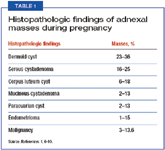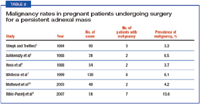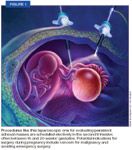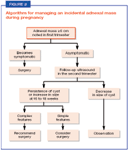Laparoscopy for adnexal masses in pregnancy? (CME)
Now that laparoscopy during pregnancy is no longer considered too dangerous, should you remove a mass this way-and if so, when?
FREE CME ONLINE
ACCREDITATION
This activity has been planned and implemented in accordance with the Essential Areas and Policies of the Accreditation Council for Continuing Medical Education (ACCME) through the joint sponsorship of CME2, Inc. ("cme2") and Contemporary OB/GYN. cme2 is accredited by the ACCME to provide continuing medical education for physicians.
cme2 designates this educational activity for a maximum of 1.0 AMA PRA Category 1 Credit™. Physicians should only claim credit commensurate with the extent of their participation in the activity.
TARGET AUDIENCE
Obstetrician/gynecologists and women's health practitioners.
EDUCATIONAL OBJECTIVES
After completing the following CME activity, the reader should be able to:
- Summarize the proper positioning of the pregnant patient for pneumoperitoneum and explain how to properly place and insert a trocar to avoid uterine injury.
- Describe the surgical techniques to establish pneumoperitoneum and identify the recommended intra-abdominal pressure to avoid maternal and fetal distress.
- Summarize the surgical management of an adnexal mass in cases of low suspicion for malignancy and in cases where malignancy is a concern.
- Recognize complications associated with adnexal masses in pregnancy and indications to perform elective surgical evaluation.
TO EARN CREDIT FOR THIS ACTIVITY
Participants should study the article, log onto http://www.modernmedicine.com, click on the "CME/CE Center" tab at the top of the page and type in keyword: COG122007. Participants will be taken to the activity, where they must pass a post-test and complete an online evaluation. After passing the post-test and completing the online evaluation, a CME certificate will be automatically generated. The release date for this activity is December 1, 2007. The expiration date is December 1, 2008.
DISCLOSURES
Editors Elizabeth A. Nissen, Paul L. Cerrato, and Julia Talsma, and Instructional Design Consultant Richard Currier, PhD, disclose that they do not have any financial relationships with any manufacturer in this area of medicine.
The manuscript reviewer discloses that he has no financial relationships with any manufacturer in this area of medicine.
Dr. Stany discloses that he has no financial relationships with any manufacturer in this area of medicine.
Dr. Elkas discloses that he is on the Speakers Bureau and Advisory Board of the Valley Lab division of Covidien, makers of laparoscopic instruments.
RESOLUTION OF CONFLICT OF INTEREST
cme2 has implemented a process to resolve conflicts of interest for each continuing medical education activity, to help ensure content objectivity, independence, fair balance, and that the content is aligned with the interest of the public. Conflicts, if any, are resolved through a peer review process.
UNAPPROVED/OFF-LABEL USE DISCUSSION
Faculty may discuss information about pharmaceutical agents, devices, or diagnostic products that are outside of FDA-approved labeling. This information is intended solely for CME and is not intended to promote off-label use of these medications. If you have questions, contact the medical affairs department of the manufacturer for the most recent prescribing information. Faculty are required to disclose any off-label discussion.
Up to 4% of patients will have an adnexal mass discovered during pregnancy, recent studies say.1-5 That's quite a change from older studies that cite an incidence of 1 in 2,300 pregnancies. No doubt increased use of ultrasound to help identify masses accounts for the greater incidence within the last few decades. The good news is that most of these masses will spontaneously resolve by 16 weeks as they are pregnancy related, most commonly corpus luteum cysts.2,6 But a small percentage of patients will have a persistent mass that requires surgical evaluation.

Adnexal masses during pregnancy need to be surgically managed in roughly one of 1,300 live births.7,8 While the vast majority of masses are benign, most commonly mature cystic teratomas (dermoid cysts) and serous cystadenomas (Table 1), a persistent adnexal mass still raises the concern for malignancy.6-10 The actual percentage of malignancy in pregnant patients with persistent adnexal masses is between 3% and 13% (Table 2).1,7-10

Laparotomy. In the past, pregnant patients who required surgical evaluation of a persistent adnexal mass underwent a laparotomy. Pregnancy was considered an absolute contraindication for laparoscopy due to the unknown effects of increased intra-abdominal pressure on a gravid uterus. That has changed within the last decade, however, as several studies comparing laparoscopy and laparotomy in pregnancy found no difference in fetal outcome between these two procedures.11,12 Furthermore, laparoscopy is commonly successful during pregnancy, with only a 3% conversion to laparotomy.13
Benefits of laparoscopy. Overall, laparoscopy is increasingly being chosen, given its many benefits over laparotomy, which are possibly even more substantial for pregnant patients. Intraoperatively, there's often less uterine manipulation when compared with laparotomy.14 Postoperatively, patients have shorter hospital stays, earlier mobilization, and a lower risk of thromboembolic events.15 Furthermore, avoidance of an abdominal scar in the face of a growing uterus can lead to less postoperative discomfort and a better cosmetic outcome.13,16
When is surgery indicated?
In general, you should consider surgical management if patients have a persistent mass 6 cm or larger at 16 to 18 weeks' gestation or have symptoms due to the mass at any time during the pregnancy (Figures 1 and 2).

This size criteria has been the recommended cut-off since most functional cysts are either smaller than this or resolve by the mid-second trimester.6

The clinical scenario should drive your management of the adnexal mass. When a complex adnexal mass persists or increases in size, it's time for surgical exploration to evaluate potential malignancy. You should also counsel patients with persistent or enlarging simple cysts to consider surgery due to other potential clinical concerns that can result from pregnancy. Pain, ovarian torsion, bleeding, and obstruction of labor are all complications of adnexal masses during pregnancy that have required emergent surgical evaluation (Table 3). Up to 28% of patients with a persistent mass have been found to require emergent surgery.8

When have you waited too long?
There are two good reasons not to wait too long to perform surgery.
1. Emergent surgical procedures and procedures after 23 weeks' gestation are more likely to lead to adverse pregnancy outcomes, including preterm delivery and intrauterinefetal demise.7,8
Therefore, even patients with persistent simple ovarian cysts 6 cm or larger should be counseled on the risks of observation versus the risks of surgical management, given the high percentage of patients requiring emergent surgery and its associated morbidity. Because of this elevated risk, most procedures for evaluating adnexal masses are scheduled electively in the second trimes ter, often between 16 and 20 week's gestation.
2. A second reason is that later gestational ages can make it harder to perform laparoscopy.
Since an enlarged uterus can interfere with adequate visualization, between 26 and 28 weeks' gestation is thought to be the upper limit for laparoscopic surgery.17 That said, it's reassuring to know that laparoscopic surgery of adnexal masses has been successful in women up to 32 weeks' gestation.18 Furthermore, a wide size range of ovarian cysts during pregnancy, which includes up to 20 cm, has been described.19
Techniques for positioning
Either the supine or low lithotomy position with a leftward tilt will decrease vena caval compression, and laterally rotating the operating table can help displace the uterus.18 Before beginning the procedure, surgeons should insert an orogastric tube for gastric decompression and place pneumatic compression devices on the patient's legs.20 Don't use transcervical instruments. Once a pneumoperitoneum has been created, use Trendelenburg position to improve visualization. While the Trendelenburg position can decrease total lung compliance and functional residual capacity, it can improve venous return and potentially improve utero-placental perfusion.17
Techniques for trocar placement and insertion
While patients-pregnant or not-are at risk for trocar injury, the gravid uterus can make it even more difficult to insert trocars and create a pneumoperitoneum. Inadvertent placement of a Veress needle through the umbilicus into the pregnant uterus does happen.21
To avoid uterine injury, subxyphoid, left- upper quadrant insertion, or right-upper quadrant points might be preferred with increasing gestation age. Lateral displacement of the uterus during trocar insertion might also lower the risk of uterine injury. Supra-umbilical primary trocar placement is common, and the surgeon should position this port at least 6 cm above the uterine fundus.13 This placement allows for adequate distance between the tip of the laparoscope and the uterus for best visualization and instrumentation. For ancillary trocar sites, additional right- and left-lower quadrant trocars are preferred if the surgeon has an assistant surgeon. Otherwise, we recommend placement of the two ports on the side contralateral to the mass. Given the anatomical distortion that occurs in a pregnant uterus, it's safer to laparoscopically visualize a spinal needle placed into the peritoneal cavity through the intended trocar site to help verify that the trocar is far enough away from the adnexal mass before actual trocar placement.
Either the Hasson (Figure 3) or the Veress needle technique can be used to establish a pneumo peritoneum in pregnant patients. However, the Veress needle technique, because it requires a blind entry, is more likely to injure the uterus or fetus, especially when inserted through the umbilicus.21 Successful insertion of the Veress needle in either the left- or right-upper quadrants in the midclavicular line 1 to 2 cm below the costal margin was described in a series of 10 pregnant patients who were all managed successfully in the third trimester.18 For safety reasons, however, other investigators advocate the open technique for trocar insertion, especially during supraumbilical port placement.10,13, 22,23 Given both options, each individual surgeon should use the technique with which he or she has the most experience.

Pneumoperitoneum: How much intra-abdominal pressure is safe?
Several animal studies have evaluated the maternal and fetal effects of increased abdominal pressure to determine the safety of laparoscopy during gestation. Experiments on gravid baboons found no adverse maternal or fetal effects with an intra-abdominal pressure of 10 mm Hg, but at 20 mm Hg, researchers discovered maternal respiratory acidosis even when they increased the ventilator rate.24 Another investigator studying pregnant sheep found an intra-abdominal pressure of 20 mm Hg had no effect on fetal placental perfusion, pH, and blood gas tension despite lowering maternal placental blood flow by 61%.25 Studies evaluating the effects of increased intra-abdominal pressure in humans during gestation, however, are lacking.
Going gasless. Given the possible adverse effects of increased intra-abdominal pressures on the hemodynamic and cardiac parameters in a pregnant patient, we caution surgeons to try to maintain pressures between 8 and 12 mm Hg, and not to exceed 15 mm Hg.16,21 For this reason, gasless laparoscopy has been proposed as a safer alternative to the traditional CO2 pneumoperitoneum.26,27 Although specialized equipment is often necessary for completely gasless laparoscopy, there are other techniques that can decrease intra-abdominal pressures through a combination of pneumoperitoneum and abdominal wall retraction.28
Potential substitute for fetal monitoring
Transabdominal fetal monitoring is not possible during laparoscopy due to the pneumoperitoneum. If a clinician believes fetal monitoring is necessary during the procedure, transvaginal ultrasound assessment of the fetal heart rate may be possible. If fetal distress occurs, we recommend hyperventilation and decreasing the intra-abdominal pressure.17
Management of the adnexal mass
Once a pneumoperitoneum has been created and the ancillary ports are placed, thoroughly inspect the pelvis and abdomen to evaluate metastatic disease. Then obtain peritoneal washings. If suspicion for malignancy is low, the surgeon must decide whether to perform a cystectomy or an oophorectomy; in most cases, a cystectomy can and should be performed.9 In cases of a known dermoid cyst, take care to avoid spilling the cyst contents to avoid chemical peritonitis.29
Several different cyst aspiration techniques have been explored to compensate for the limited operative field with the gravid uterus. One group described successful management of masses by mobilizing the adnexa laparoscopically through a 2- to 3-cm transverse abdominal incision where the contents are then aspirated extraperitoneally and the cystectomy completed.10 Other techniques involve suturing the cyst wall while using an aspirator to drain the cyst contents to minimize spillage.19 If there's any concern for malignancy, however, the surgeon should opt to convert to laparotomy for appropriate excision and staging.
While large prospective studies evaluating the safety of laparoscopy in pregnancy are lacking, retrospective studies have shown this procedure to have similar risks as for nonpregnant patients. Given the potential of a malignancy or the morbidity of emergent surgery, patients with persistent adnexal masses larger than 6 cm at 16 to 18 weeks' gestation should be scheduled for elective surgical evaluation in the second trimester. With special attention to trocar placement, intra-abdominal pressure, and surgical technique, laparoscopy should be considered for pregnant patients requiring surgical management of adnexal pathology.
DR. STANY is a Fellow, Division of Gynecologic Oncology, Walter Reed Army Medical Center, Washington, DC, and DR. ELKAS is an Attending Gynecologic Oncologist, Northern Virginia Pelvic Surgery Associates, Annandale, Va.
The views expressed herein are those of the authors and do not reflect the official policy or opinion of the Department of Defense or the United States Army.
REFERENCES
1. Ashkenazy M, Kessler I, Czernobilsky B, et al. Ovarian tumors in pregnancy. Int JGynaecol Obstet. 1988;27:79-83.
2. Nelson MJ, Cavalieri R, Graham D, et al. Cysts in pregnancy discovered by sonography. J Clin Ultrasound. 1986;14:509-512.
3. Yuen PM, Chang AM. Laparoscopic management of adnexal mass during pregnancy. Acta Obstet Gynecol Scand. 1997;76:173-176.
4. Hill LM, Connors-Beatty DJ, Nowak A, et al. The role of ultrasonography in the detection and management of adnexal masses during the second and third trimesters of pregnancy. Am J Obstet Gynecol. 1998;179:703-707.
5. Bernhard LM, Klebba PK, Gray DL, et al. Predictors of persistence of adnexal masses in pregnancy. Obstet Gyne - col. 1999;93:585-589.
6. Struyk AP, Treffers PE. Ovarian tumors in pregnancy. Acta Obstet Gynecol Scand. 1984;63:421-424.
7. Whitecar MP, Turner S, Higby MK. Adnexal masses in pregnancy: a review of 130 cases undergoing surgical management. Am J Obstet Gynecol. 1999;181:19-24.
8. Hess LW, Peaceman A, O'Brien WF, et al. Adnexal mass occurring with intrauterine pregnancy: report of fifty-four patients requiring laparotomy for definitive management. Am J Obstet Gynecol. 1988;158:1029-1034.
9. Ribic-Pucelj M, Kobal B, Peternelj-Marinsek S. Surgical treatment of adnexal masses in pregnancy: indications, surgical approach and pregnancy outcome. J Reprod Med. 2007;52:273-279.
10. Mathevet P, Nessah K, Dargent D, et al. Laparoscopic management of adnexal masses in pregnancy: a case series. Eur J Obstet Gynecol Reprod Biol. 2003;108:217-222.
11. Soriano D, Yefet Y, Seidman DS, et al. Laparoscopy versus laparotomy in the management of adnexal masses during pregnancy. Fertil Steril. 1999;71:955-960.
12. Reedy MB, Kallen B, Kuehl TJ. Laparoscopy during pregnancy: a study of five fetal outcome parameters with use of the Swedish Health Registry. Am J Obstet Gynecol. 1997;177:673-679.
13. Yuen PM, Ng PS, Leung PL, et al. Outcome in laparoscopic management of persistent adnexal mass during the second trimester of pregnancy. Surg Endosc. 2004;18:1354-1357.
14. Stepp K, Falcone T. Laparoscopy in the second trimester of pregnancy. ObstetGynecol Clin North Am. 2004;31:485-496, vii.
15. Andreoli M, Servakov M, Meyers P, et al. Laparoscopic surgery during pregnancy. JAm Assoc Gynecol Laparosc. 1999;6:229-233.
16. Levy T, Dicker D, Shalev J, et al. Laparoscopic unwinding of hyperstimulated ischaemic ovaries during the second trimester of pregnancy. Hum Reprod. 1995;10:1478-1480.
17. Fatum M, Rojansky N. Laparoscopic surgery during pregnancy. Obstet Gynecol Surv. 2001;56:50-59.
18. Upadhyay A, Stanten S, Kazantsev G, et al. Laparoscopic management of a nonobstetric emergency in the third trimester of pregnancy. Surg Endosc. 2007;21:1344-1348.
19. Stepp KJ, Tulikangas PK, Goldberg JM, et al. Laparoscopy for adnexal masses in the second trimester of pregnancy. J Am Assoc Gynecol Laparosc. 2003;10:55-59.
20. Surgeons SoAGE. SAGES Guidelines for laparoscopic surgery during pregnancy 2004-26-2007].
21. Reedy MB, Galan HL, Richards WE, et al. Laparoscopy during pregnancy. A survey of laparoendoscopic surgeons. J Reprod Med. 1997;42:33-38.
22. Lin YH, Hwang JL, Huang LW, et al. Successful laparoscopic management of a huge ovarian tumor in the 27th week of pregnancy. A case report. J Reprod Med. 2003;48:834-836.
23. Roman H, Accoceberry M, Bolandard F, et al. Laparoscopic management of a ruptured benign dermoid cyst during advanced pregnancy. J Minim Invasive Gynecol. 2005;12:377-378.
24. Reedy MB, Galan HL, Bean-Lijewski JD, et al. Maternal and fetal effects of laparoscopic insufflation in the gravid baboon. J Am Assoc Gynecol Laparosc. 1995;2:399-406.
25. Barnard JM, Chaffin D, Droste S, et al. Fetal response to carbon dioxide pneumoperitoneum in the pregnant ewe. Obstet Gynecol. 1995;85:669-674.
26. Melgrati L, Damiani A, Franzoni G, et al. Isobaric (gasless) laparoscopic myomectomy during pregnancy. 2005;12:379-381.
27. Oguri H, Taniguchi K, Fukaya T. Gasless lapa roscopic management of ovarian cysts during pregnancy. Int J Gynaecol Obstet. 2005;91:258-259.
28. Stany MP, Winter WE 3rd, Dainty L, et al. Laparoscopic exposure in obese high-risk patients with mechanical displacement of the abdominal wall. Obstet Gynecol. 2004;103:383-386.
29. Mendilcioglu I, Zorlu CG, Trak B, et al. Laparoscopic management of adnexal masses. Safety and effectiveness. J Reprod Med. 2002;47:36-40.
